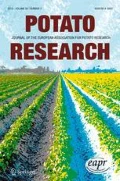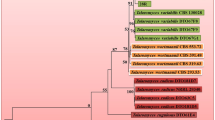Abstract
The perennial herb Chlorophytum nepalense (Lindley) Baker, widely distributed throughout the northern parts of Tripura State of India, is used traditionally by Tripuri farmers as a root extract to control dark viral necrotic lesions of sprouted potato tubers and plants. The root extracts strongly reduced infection of potato plants and sprouted tubers by Potato virus X under glasshouse conditions. The root extract was found to contain the three plant-viricidal compounds chlorogenic acid, kaempferol-3-O-(3′,6′di-O-E-p-coumaroyl)-β-d-glucopyranoside, and luteolin and suggests that the isolated compounds may have the potential to be used as natural plant-viricidal compounds.
Similar content being viewed by others
References
Adams SE, Jones RAC, Coutts RHA (1986) Effect of temperature on potato virus X infection in potato cultivars carrying different combinations of hypersensitivity genes. Plant Pathol 35(4):517–526
Afroz S, Tutul E, Uddin MZ, Hassan MA (2008) Chlorophytum nepalense (Lindley) Baker (Liliaceae)—a new angiospermic record for Bangladesh. Bangladesh J Bot 37(2):193–194
Awasthi LP, Mukerjee K (1980) Protection of potato virus X infection by plant extracts. Biol Plantarum (Praha) 22(3):205–209
Bawden FC, Kassanis B, Roberts FM (1948) Studies on the importance and control of Potato Virus X. Ann Appl Biol 35:250–265
Berks R (1970) Potato virus X. No. 4. In: CMI/AAB Description of plant viruses, Kew, Surrey, England.
Beukema HP, van der Zaag DE (1979) Potato improvement. International Agriculture Centre, Wageningen
Biswas MK, De BK, Nath PS (2005) Rate of spread of PVX, PVY and PLRV diseases to potato varieties. Annals Plant Prot Sci 13:175–178
Blaszczak W, Ross AF, Larson RH (1959) The inhibitory activity of plant juices on the infectivity of potato virus X. Phytopathol 49:784–791
Clark MF, Adams AN (1977) Characteristics of the microplate method of enzyme-linked immunosorbent assay for the detection of plant viruses. J Gen Virol 34:574–586
Close R (1964) Some effects of other viruses and of temperature on the multiplication of potato virus X. Ann Appl Biol 53(1):151–164
Cohen Y, Gisi U, Mosinger E (1991) Systemic resistance of potato plants against Phtophthora infestans induced by unsaturated fatty acids. Physiol Mol Plant Pathol 38:255–263
Deb DB (1981) The flora of Tripura state. Today and Tomorrow's Printers and Publishers, New Delhi
Erkan S, Yorganci U (1982) Investigations on the inhibition of Potato Virus X (PVX) infectivity by some plant extracts. J Turk Phytopathol 11:61–75
French CJ, Towers GHN (1992) Inhibition of infectivity of potato virus X by flavonoids. Phytochemistry 31(9):3017–3020
Hooker JD (1892) The flora of British India. L Reeve & Co Ltd, Kent
Jeeshna MV, Paulsamy S (2011) Evaluation of certain flavonoids of medicinal importance in the wild and micropropagated plants of the endangered medicinal species, Exacum bicolor Roxb. J Appl Pharmaceut Sci 01(05):99–102
Joshi N, Kehlenbeck K, Maass B L (2007) Traditional, neglected vegetables of Nepal: their sustainable utilization for meeting human needs. Conference on International Agricultural Research for Development, University of Gottingen. http://www.tropentag.de/2007/abstracts/full/322.pdf. Accessed 25 Nov 2011
Kempiak G, Schuster G, Awasthi LP, Kluge S (1991) Attempts to reduce damage caused by oat sterile dwarf virus in oats using virazole, 2,4-dioxohexahydrotriazine, Boerhaavia inhibitor and alkane-monosulfonate. Acta Phytopathologica et Entomologica Hungarica 26:219
Khare CP (2007) Indian medicinal plants, an illustrated dictionary. Springer Science, LLC, New York
Killick RJ (1979) The effect of infection with potato leaf roll virus on yield and some of its components in a variety of potato (Solanum tuberosum L.). Ann Appl Biol 91(1):67–74
Loughnane JB, Murphy PA (1938a) Mode of dissemination of potato virus X. Nature 141:120–121
Loughnane JB, Murphy PA (1938b) Dissemination of potato viruses X and F by leaf contact. Sci Proc Roy Dublin Soc (NS) 22:1–15
Lyon NC, Pergrine WTH (1974) Prevalence of potato virus X, S and M in Malawi. Trop Agric Trinidad 51:543–547
Malhotra B, Onyilagha JC, Bohm BA, Towers GHN, James D, Harborne JB, French CJ (1996) Inhibition of tomato ringspot virus by flavonoids. Phytochemistry 43:1271–1276
Manzer FE, Merriam D (1961) Field transmission of the potato spindle tuber virus and virus X by cultivating and hilling equipment. Am Potato J 38:346–352
Merriam D, Bonde R (1954) Dissemination of spindle tuber by contaminated tractor wheels and by foliage contact with diseased plants. Phytopathology 44:111
Miha AM, Rossel HW, Atiri GI (1993) Incidence and distribution of potato viruses in plateau state, Nigeria. Afr Crop Sci J 1:131–138
Munro J (1981) Potato virus X. In: Hooker WF (ed) Compendium of potato diseases. American Phytopathological Society, St. Paul, pp 72–77
Nayar NM (1989) Importance and problems in breeding virus resistant potato varieties. In: National Symposium on Epidemiology of Viral Diseases. Hilma, India, pp14
Rowe RC (1993) Potato health management. In: Rowe RC (ed) Potato health management. American Phytopathological Society (APS Press), St. Paul
Salazar LF (1990) Main virus diseases of potato. In: CIP, control of virus and virus-like diseases of potato and sweet potato. Report 3rd Plan Conf, Lima, Peru, pp 9–12
Shen JG, Zhang ZK, Wu ZJ, Ouyang MA, Xie LH, Lin QY (2008) Antiphytoviral activity of bruceine-D from Brucea javanica seeds. Pest Manag Sci 64:191–196
Singh R, Singh R (1973) Properties of an inhibitor of potato virus X from bark of Ficus elastica. Ind Phytopathol 26:560–563
Singh RA, Parihar SBS, Singh MN (1977) Inhibition of potato virus X by Rumex haustatus extract. Sci Cult 43:268–269
Srivastava N, Verma HN (1995) Chenopodium murale leaf extract, a potent virus inhibitor. Indian Phytopath 48:177–179
Steel RGD, Torrie TH (1980) Principles and procedures of statistics. McGraw-Hill, New York
Taniguchi T, Goto T (1976) Purification of an inhibitor of plant virus infection occurring in leaves of Chenopodium amaranticolor. Ann Phytopathol Soc Japan 42:42–45
Todd JM (1958) Spread of potato virus X over a distance. Proc 3rd Conf Potato Virus Diseases, Lisse-Wageningen, pp 132–143
Verma HN, Baranwal VK (1983) Antiviral activity and the physical properties of the leaf extract of Chenopodium ambrosoides L. Proc Ind Acad Sci (Plant science) 92:461–465
Verma HN, Dwivedi SD (1984) Properties of a virus inhibiting agent, isolated from plants which have been treated with leaf extracts from Bougainvillea spectabilis. Physiol Plant Pathol 25:93–101
Verma HN, Mukerjee K (1979) Induction of antiviral resistance in host plants by Datura leaf extract. Indian Phytopath 32:95–97
Verma VS, Raychaudhuri SP, Khan MA (1969) Properties and nature of inhibitors of potato virus X in four medicinal plant extracts. Biol Plantarum 11:384–387
Verma VS, Raychaudhuri SP, Khan MA (1970) Effect of medicinal plant extracts on the infectivity of potato virus X. Planta Med 18:177–184
Verma HN, Awasthi LP, Saxena KC (1979) Isolation of the virus inhibitor from the root extract of Boerhaavia diffusa inducing systemic resistance in plants. Can J Bot 57:1214–1217
Vivanco JM, Querci M, Salazar LF (1999) Antiviral and antiviroid activity of MAP-containing extracts from Mirabilis jalapa roots. Plant Dis 83:1116–1121
www.banglajol.info/index.php/BJPT/article/download/2750/2316 (downloaded on 10.05.2011)
www.niscair.res.in/sciencecommunication/abstractingjournals/isa/isa2k11/isa_16nov11.asp (downloaded on 14.06.2012)
Xinqi C, Tamura MN (2000) Flora of China. Science Press, Beijing, China
Acknowledgments
The author wishes to thank Dr. Colin Jeffries, SASA, UK, for help with this article.
Author information
Authors and Affiliations
Corresponding author
Rights and permissions
About this article
Cite this article
Acharya, S. Control of the Potato Virus X Through Application of Root Extracts of Chlorophytum nepalense to Potato Plants and Tubers. Potato Res. 56, 1–10 (2013). https://doi.org/10.1007/s11540-012-9227-4
Received:
Accepted:
Published:
Issue Date:
DOI: https://doi.org/10.1007/s11540-012-9227-4




